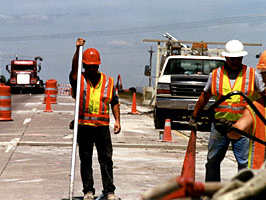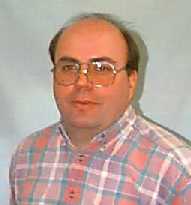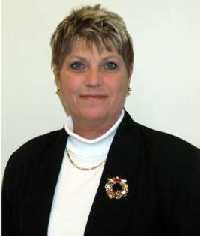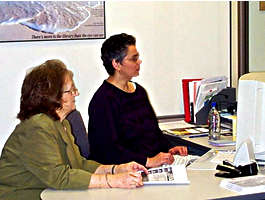 |
 |





 |
 |
 |
 |
 |
 |
State regulation requires new high visibility apparel in work zones
|
 |
 |
 |
Effective Jan. 1, employees
in work zones must wear new higher visibility safety apparel. Photo
by Dave Gonzalez
|
All state employees exposed to moving motor vehicles or mobile earth-moving
equipment must wear new higher visibility safety apparel, according to Larry
Thompson, Mn/DOT’s safety and health director.
Effective Jan. 1, a new Minnesota Occupational Safety and Health Administration
standard requires that garments have a minimum of 775 square inches of fluorescent
yellow-green or orange-red background material and a minimum of 201 square inches
of retro-reflective material.
Employees in work zones during daylight conditions are required to wear a high
visibility vest and hardhat or high visibility soft cap. If engaged in flagging
activities or when working in low-light conditions, high visibility pants are
required in addition to the high visibility vest and cap, Thompson said.
The old mesh or open weave background materials used in warning vests will
not meet the background color requirements, Thompson said. The orange cotton
T-shirts many employees wear will not meet the washing requirements and typically
do not have the retro-reflective material required by the new standard.
In addition, high visibility apparel that becomes faded, torn, dirty, worn
or defaced, must be immediately removed from service and replaced, he said.
The easiest way employees can tell if their current high visibility garment
meets the new high visibility apparel requirements is to look for a pictogram
displayed in the back inside collar of the garment. The "X" will tell
you the Class of the garment, which now must be ANSI/ISEA Class 2 or greater.
Employees should contact their safety administrator for more information.
Over the past decade, Mn/DOT has been viewed as a national leader in the area
of high visibility apparel, Thompson said. Enhancing the visibility of employees
working in construction and maintenance work zones through refining high visibility
apparel involved employee feedback, motorist perception surveys and field observation
studies.
The result is the high visibility apparel Mn/DOT employees wear today that
not only meets the new standard adopted by MNOSHA, he said, but exceeds the
standard for the high visibility industry.
By Mary Meinert
|
back

|
 |
Shaping Our Future changes will make Mn/DOT work better
|
 |
 |
The governor’s State of the State address Jan. 3 drove home what state officials
have known for weeks: the pressure is on for government agencies to find ways
to address a projected $2 billion shortfall this biennium while delivering essential
programs and services to Minnesotans.
"It is my belief," Gov. Jesse Ventura told his televised audience,
"that when we are facing a $2 billion deficit, we should concentrate on
what is necessary and not necessarily on what’s nice."
Fortunately for Mn/DOT, said Deputy Commissioner Doug Weiszhaar, the department
already began this work more than a year ago.
"Despite a challenging year, we’re being aggressive in finding new and
better ways to deliver transportation choices to Minnesota citizens," he
said. "Our employees have been working over the past year to streamline
our processes to make Mn/DOT work better."
Last July, Mn/DOT launched "Shaping Our Future," a plan to realign
staff and reallocate funds in response to customer demands for more benefits
from the money invested in transportation.
Shaping Our Future changes underway or planned include:
-
Developing a change management process (Dick Stehr, change manager)
-
Developing the biennial budget (Kevin Gray, change manager)
-
Streamlining program delivery (Del Gerdes, change manager)
-
Consolidating capitol complex and modal offices shared business services
(Rich Peterson, change manager)—see article below
-
Focusing on strategic staffing (Wayne Brede, change manager)
-
Coordinating training (Cathy Walz, change manager)
In addition, several offices are undergoing internal review to better align
and, in some cases, consolidate business functions as part of the department’s
distributed products and services model. These offices are:
-
Land Management (in progress)
-
Materials & Road Research/ Research (plans due 1/31)
-
Consultant Services/ Contract Management (plans due 2/22)
-
Administrative Services/ Communications & Public Relations (plans due
3/1)
-
Environmental Services (plans due 3/1)
-
Technical Support (plans due 3/1)
-
Maintenance (plans due 4/19)
"In the end, these efforts might mean that some people will do different
work," Weiszhaar said. "It doesn’t mean that their current work is
not important—only that we need to focus on meeting the department’s priorities
of delivering the construction program to more effectively address customer
needs."
Shaping Our Future change managers are committed to communicating all changes
with employees on a regular basis. If you have questions or would like to comment
about Mn/DOT’s Shaping Our Future efforts, send an e-mail to: change@dot.state.mn.us.
Related information links:
|
Shared business services consolidation efforts announced
Jan. 7
Mn/DOT will consolidate shared business services in the department’s
capitol complex offices and its modal offices, Rich Peterson, Human
Resources, told business operations employees on Jan. 7.
The changes are based on a model the Office of Human Resources developed
for improving delivery of business operations in Central Office. The
Senior Management Team approved the recommendations on Dec. 17.
The consolidation will move common business functions such as human
resource transactions, financial transactions (payroll, accounts receivable,
accounts payable), fleet management, facilities management and general
administration to the appropriate specialty office. General office functions,
such as reception, filing and photocopying, will not be affected.
About 130 business operations employees in the Management Operations
Group, Program Support Group, Program Delivery corporate and modal offices,
Corporate Business Group, State Aid for Local Transportation Group and
Chief of Staff offices will be affected by the consolidation.
The goal of consolidation is to improve delivery of business services
by aligning common functions with the appropriate specialty office,
said Peterson, who is project manager. A consolidation implementation
team will review employee expertise and interests and consider the needs
of the department before reallocating employees to different positions.
"Getting the right people, with the right skills, at the right
place, at the right time, will help us get closer to a customer-focused
products and services model." Peterson said.
For more information, see the Shared
Business Services Consolidation Web site. See also the PowerPoint
presentation. A list of questions (with responses) from the Jan.
7 meeting will be posted on the Web site next week.
|
|
back

|
 |
State receives $436 million in federal funding
|
 |
 |
Minnesota will receive nearly $436 million from federal funding sources for
the 2002 fiscal year.
The state received $358 million for fiscal year 2002 from the federal Highway
Trust Fund for locally selected transportation projects. This is an increase
of about $20 million from the previous fiscal year.
In addition, Minnesota will receive $42.9 million in funding for new projects
selected by Congress. The state will also receive $35 million for transportation
projects previously selected by Congress.
The funds will be used for purposes such as bridge replacement and rehabilitation,
highway corridor planning, road construction and for transportation system and
community preservation projects, said Frank Vandesteeg, director of the Project
Authorization Unit, Office of Investment Management.
Vandesteeg said monies appropriated from the Highway Trust Fund are earmarked
for projects approved via the Area Transportation Partnership process and included
in the State Transportation Improvement Plan.
Although appropriations for Minnesota from the trust fund were significantly
higher for this fiscal than last, preliminary indications show the state’s share
might drop by as much as $70 million for 2003, Vandesteeg added. The forecast
for 2003 is based on taxes collected from vehicle fuel consumption in 2001.
The decline in the economy and other factors combined to lower consumption
and tax revenues, he said.
By Craig Wilkins
|
back

|
 |
New course will develop leaders to shape Mn/DOT’s future
|
 |
 |
Changing times require new leaders with new thinking and new approaches. That
message is at the heart of a new leadership course Mn/DOT will offer to cultivate
leaders with the characteristics needed to help guide the organization in the
future.
Beginning April 30, Mn/DOT managers, supervisors and employees in leadership
positions will have the chance to attend a customized 12-month leadership course
that could help attendees deliver actual projects during the course itself.
It’s called "Leadership Excellence," and Feb. 15 is the deadline to
apply or to nominate someone else.
"This is very different from anything we’ve done before," said Kari
Schamber, leadership development project manager, Office of Human Resources.
"It’s not a five-day program where you get magically transformed into a
leader. Instead, it’s a monthly program where we meet for one day a month, and
participants have time to try on this new behavior to see how it works, then
report back to class for fine-tuning."
"Leadership Excellence will nurture the character traits that Mn/DOT has
identified as what we need to deliver Moving Minnesota," Schamber said.
These traits—which include risk taking, acting decisively, ethics and values,
change management, communications skills and managing relationships—also form
the core competencies that managers and supervisors use to evaluate employees
during performance reviews, she said.
The class structure will interrelate with attendees’ jobs and present opportunities
for hands-on learning. Although daylong sessions will feature speakers from
inside and outside of Mn/DOT, case study discussions will predominate.
The schedule will also include time for "action learning teams" of
people teamed up to research an area and put together presentations that they
will give in class, Schamber said. "Participants will also work on real
issues or real problems so that we will actually get some Mn/DOT work done through
this class. This way, we build the skills in class; we won’t just lecture at
them."
Since Leadership Excellence can only accommodate 30 participants at a time,
a nomination and selection process will determine the roster. For this first
round, Schamber said, managers and supervisors may nominate each other or an
employee who’s been identified in succession planning. Employees can self-nominate
as well, she added.
"In these dynamic, ever-changing times, the development of excellent leaders
is not a luxury but a necessity," said Doug Weiszhaar, Deputy Commissioner.
"Our future success at Mn/DOT requires that we develop the leadership abilities
of our employees."
Contact Schamber at 651/296-9772 before Feb. 15 for more information or nomination
forms.
|
back

|
 |
Mankato appoints new design engineer, transit coordinator
|
 |
 |
 |
Rolin Sinn. Photo
by Rebecca Arndt
|
Rolin Sinn recently accepted the position of District Design Engineer and Janice
Kassen accepted the position of transit manager with the Mankato District.
Sinn has managed projects in the preliminary, hydraulic and final design phases
of state highway projects. He has been the hydraulics engineer for the past
10 years at the Mankato Mn/DOT office. Prior to that he worked in the Northwest
District for 7 years in design and construction.
Sinn holds a bachelor of science degree in civil engineering from the University
of Minnesota. He can be reached at 507/389-6356.
Janice Kassen, formerly the director of the Cottonwood County Transit System,
accepted the position of transit manager with the Mankato District. In her new
position, she will provide technical assistance to 11 transit systems in south
central and southwestern Minnesota and help establish new systems and expand
existing ones.
 |
|
Janice Kassen. Photo
by Rebecca Arndt
|
Klassen will also work on other initiatives, such as transit systems’ sharing
vehicles and improving communication and coordination of transit services.
Klassen succeeds Mark Scheidel who accepted a planning position with the district.
Her previous experience also includes serving as economic development coordinator
for the city of Mountain Lake.
Klassen may be reached at 507/389-6351 in Mankato or at 507/831-1200 in Windom.
|
back

|
 |
Mn/DOT Library marks 45 years of service
|
 |
 |
 |
The computer has become
an invaluable tool for Mn/DOT library staff members, including Olive Nerem
(left) and Shirlee Sherkow. Besides the World Wide Web, the library has
access to several engineering and transportation databases as well as
the collections of other libraries. Photo by Jim Byerly
|
Moving Minnesota's transportation information is the foundation of Mn/DOT Library,
which celebrates its 45th anniversary this year. Begun in 1957 by the Department
of Highways as a place to store reading materials, Mn/DOT Library is now recognized
as the leading state transportation agency library in the country.
According to Jerry Baldwin, Mn/DOT library director, the creation of the interstate
highway system also created a need for a central location of materials on the
federal standards for designing and constructing the interstate system.
During the first years of the library, much of the information related to public
safety, which was then part of the Highway Department's responsibilities. After
the creation of the Department of Public Safety, the library focused heavily
on pavement and bridge information. In 1972, when Baldwin came on board as a
library technician, the transformation began to a technical library, pioneering
the use of online databases and electronic communications to fill requests for
information on all aspects of highways for department employees.
With the creation of the Department of Transportation in 1976, the library
broadened its scope to cover today's multi-modal field of transportation.
"Now we serve the state's entire transportation community and are a core resource
for other regional, national and international library networks," said Baldwin.
"The library's 45th anniversary, including 25 years of service to Mn/DOT, is
a real milestone. We think the future will bring an even greater need for cutting-edge
information in order to stay abreast of the ever-changing world of transportation
technology."
In fact, Mn/DOT Library currently is collaborating with the recently created
National Transportation Library and other libraries in developing networks that
will be better able to provide Mn/DOT access to the latest information on transportation
technologies and techniques from around the country and the world.
For more information, see the Mn/DOT Library Web site.
By Gail Gendler
|
back

|
 |
Last call for Pride Award nominations for Transportation Conference
|
 |
 |
Take the opportunity to acknowledge a co-worker or external partner for their
part in Moving Minnesota by nominating them for a Mn/DOT Pride Award.
The deadline for nominations is Jan. 11.
Nominees and winners will receive recognition at the transportation conference,
which will be held Feb. 12-13 at the Radisson South in Bloomington.
To nominate someone, print and complete a nomination form at: http://www2.dot.state.mn.us/transconf2002.
Sample nominations are on the Web site. Nominations should include specific
examples to support the nominee’s performance in transportation systems leadership,
management or information.
Send the completed form to Kathy Lehner at MS 150 or fax it to 651/297-4776.
More information about the transportation conference will be in next week’s
Mn/DOT Newsline.
|
back

|
|
 |
|



